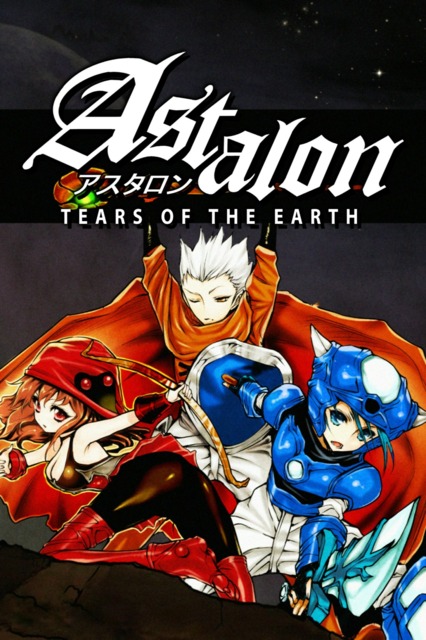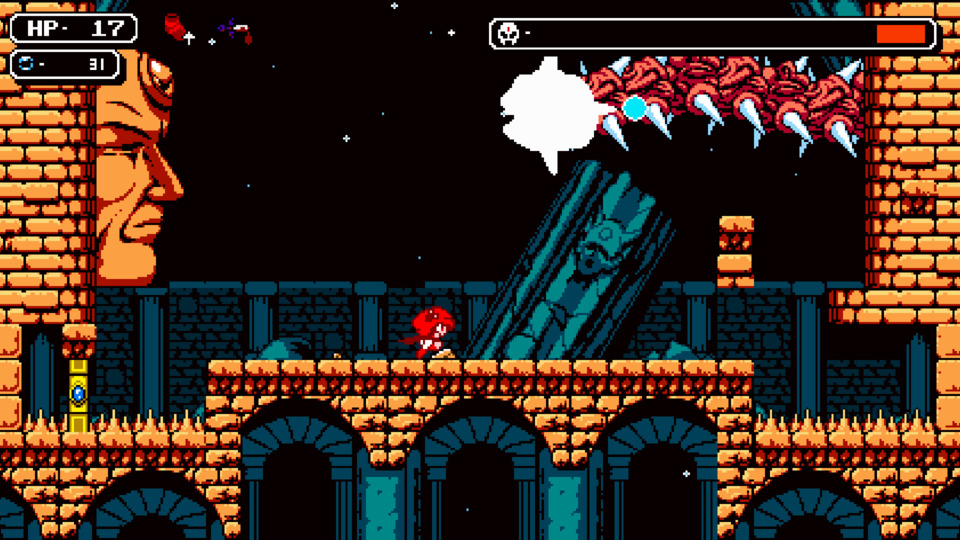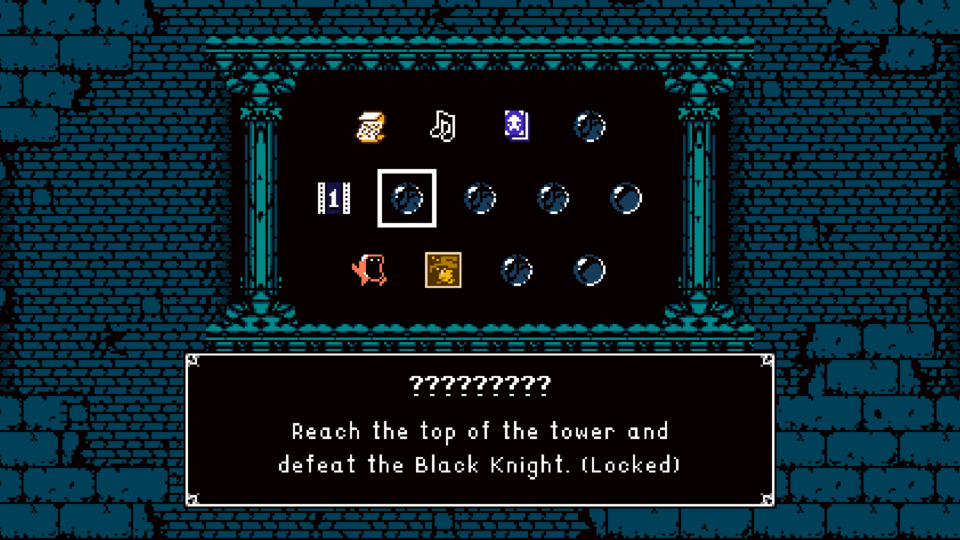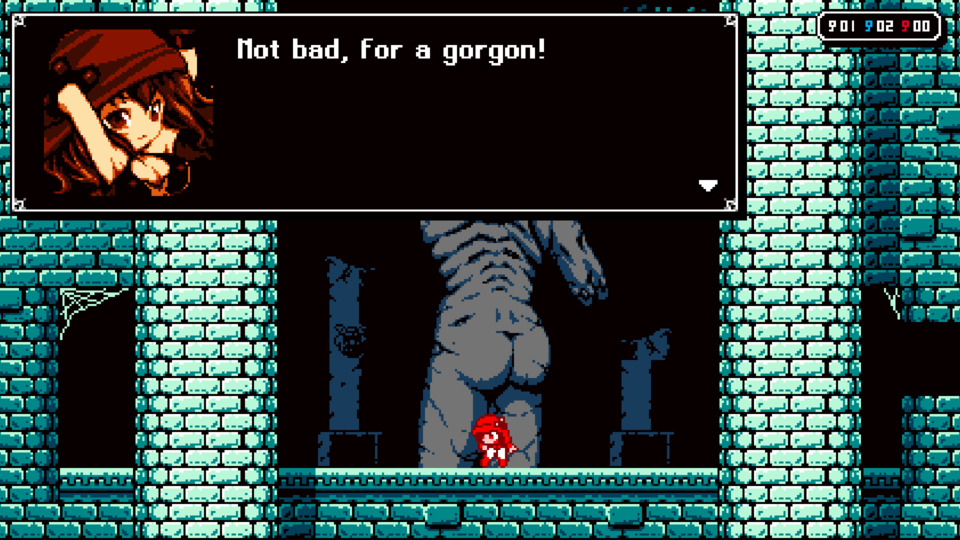
A selection that shouldn't surprise anyone who reads these things with any regularity, this Indie Game of the Week will cover LabsWorks's Astalon: Tears of the Earth from 2021, an 8-bit style explormer from the development lead that released the equally-gruelling 8-bit style explormer Castle in the Darkness (dude has a type). Three heroes approach an ominous tower in the middle of a desert determined to find the source of a poison that is choking their home village. Arias the swordsman, Kyuli the archer, and Algus the mage are characters with their own strengths and weaknesses, and much like forebears such as Legacy of the Wizard or Magicians & Looters they each have specific progress-enabling skills that means you'll need to switch between them fairly often to make steady progress.
The first deviation from the norm I've noticed when playing Astalon is that the game goes hard. It's not just difficult in terms of its level and encounter design either, but seemingly as an overall guiding philosophy. Healing is almost non-existent, campfires let you save but they're not so much respawn checkpoints as they are just opportunities to switch characters and save any item/map progress you've made, and though many passive upgrades exist to purchase you actually have to die first to access the shopkeeper that sells them. Fortunately(?), you'll be dying a lot, as the game throws some tough boss encounters your way in-between just trying to get around safely with an ever-dwindling health supply. In some ways, it's incorporated the run-based aspirations of its mechanically close peer Rogue Legacy and its sequel: you're likely to fall more than a few times en route to the next progress milestone, but the opportunity to improve your characters during this interstitial also provides encouragement that the next expedition will prove more fruitful. I'm honestly OK with all of this for as much as harder platformers can make me see red, given the explormer genre has already branched out to include elements taken from the challenging Souls RPGs as well as the aforementioned harsh realities of run-based games that are perfectly fine with dropping you off a cliff on a regular basis (plus, I recently beat La-Mulana 2, so it feels like I've become habituated to a lot of arbitrary hardship). The added challenge means meaningful progress feels more earned, and bosses feel more satisfying when you finally defeat them.

I'm a little less enamoured by how often I've entered a room, seen some wall sconce or wall of vines that can only be removed by Algus or Arias respectively and had to hoof it back to the last campfire I passed to switch to that character. I spend most of my time as the rogue Kyuli as she has a wall-jump that makes the platforming easier as well as a powerful ranged attack that keeps me out of harm's way, which is all the more essential with how the game's been designed where you can only withstand so many errors. I've also unlocked a fourth character, suggesting perhaps that there's even more barrier types I'm going to have to keep substituting around to overcome. The game's map is deeply intricate with many hidden rooms and mysteries that take some time to figure out. An early upgrade will helpfully mark rooms by the type of key they need for any locked exits contained within, making that aspect of backtracking easier, but there's still many other fine details you might be inclined to note down yourself. Combat is purposefully simple to maintain the 8-bit connection—each character has their focus, whether it's Arias's melee that eventually allows him to deflect projectiles, Kyuli's long distance arrows, or Algus's magic that can pass through walls but has a fairly limited range—but it's very responsive in how you can carefully thread yourself around enemy attacks, is enhanced further with some modular upgrades (you can improve strength, defense, and attack speed, and each character has three unique combat skills also), and most enemy encounters require you to stay on your feet to avoid getting ambushed. I've had multiple fights where I spent some significant portion dancing around and through the gaps in projectiles like it was a danmaku game, though Astalon's far from something like Outland where that gameplay similarity was a more deliberate choice.
On top of the slow but rewarding map exploration, the game's story starts with a twist and gets ever more complicated as you keep traversing the central tower, giving you questions to ponder and mechanics to incorporate into the next attempt to ascend further. One such system that takes some experimentation to discover (and apologies for spoiling it here) is the way you can find and destroy vampiric stone heads that hit you with some damage—never something you'd normally incur purposefully, given your healing options are very strictly controlled—in exchange for a power-up that doubles all incoming currency. You can also combine it with two others for a total of 8x the multiplier, though this also means being close to critical health depending on how often you've upgraded your maximum HP. It's a risk vs. reward system perhaps not worth entertaining if you're preparing to take on the next boss, but if you're scouring earlier floors for secrets or areas you couldn't access before a recent upgrade it's a little more enticing a prospect. The many upgrades you can purchase, most of which are character specific, eventually mold the playthrough to suit how you've chosen to play the game: for instance, as I noted before I spend most of my time as Kyuli, so she's received most of the character-specific upgrades to her attack strength and defense; however, I'm also not neglecting the other characters as there have been times I've had to rely on them alone to make it through areas, and I'm more inclined to pick the upgrades that apply to the whole team like one that increases the invincibility window after getting hit. There's been a fair number of times where I've questioned my upgrade choices, or wondered what the point of certain seemingly-empty rooms might be, or found myself unlocking a bestiary system or a sudden new side-quest while poking around some innocuous area of the map. It's made the game more entertaining on a moment-to-moment basis as a result, even if it feels like I spend most of the time recovering lost ground after yet another unfortunate demise.

Graphically, the pixel art is as adequate as it tends to be in throwbacks like this: there's a certain limited amount of colors and some basic character/enemy designs due to the pixel count (though the full resolution is, of course, far beyond what the NES could manage), though the bosses and some of the backgrounds have been a little more elaborately designed. The anime-styled portraits can be switched out for more western-looking ones via a certain unlockable secret if they're more your flavor. Musically, I've enjoyed the game's compositions quite a bit, and they stick out whenever you reach a new area of the tower and are treated to some new BGM. There's also moments and rooms where the music drops away entirely, creating an ominous silence that adds to the mystique of the tower's more secluded areas. On the whole, I'd say the presentation was unexceptional especially with the number of competitors opting for something similar, but far from poor either.
I remain in Astalon's grasp for the time being, curious to see what the next part of the tower is like after defeating its second boss (of six; the map completion % also concurs that I'm about a third done after some six or seven hours) and how much more challenging it intends to be. Popping my head into some high-level areas has already humbled me and my current upgrade progress with some real tough foes, so I'm going to have to be ever more vigilant about avoiding damage and not taking risks as I keep exploring upward. Happily, though deaths always reset you to the start of the tower, there's been a steady procession of unlocked elevators and warp gates to get around in a flash, and I've unlocked a corpse run-adjacent upgrade that gives me bonus max HP if I can reach where I last died that I'm finding helps mitigate the cost of going for those currency doublers or outlasting bosses. The game's a toughie but I'm not one to back down from a fight. I mean, unless we're talking in real life rather than a video game, in which case I'm leaving a me-shaped cloud of dust behind as I head in the opposite direction.

Rating: 4 out of 5.
Post-Playthrough Edit: OK, the game definitely gets better as you keep going. One of the upgrades addresses a shortcoming that I sort of wish was built in from the start (regarding the swapping of characters) and the challenge level and secret-finding remain compelling right until the end. In true Castlevania fashion, there's a few bonus campaigns that have you tackle the same map with alternative protagonists with distinct gameplay changes, so there's some decent replay value if you're really gunning for that Platinum (or equivalent). One of them feels like a Gargoyle's Quest shout out, which is always a welcome sight to see.
| < Back to 290: Alba: A Wildlife Adventure | The First 100 | The Second 100 | > Forward to 292: Red Bow |
Log in to comment